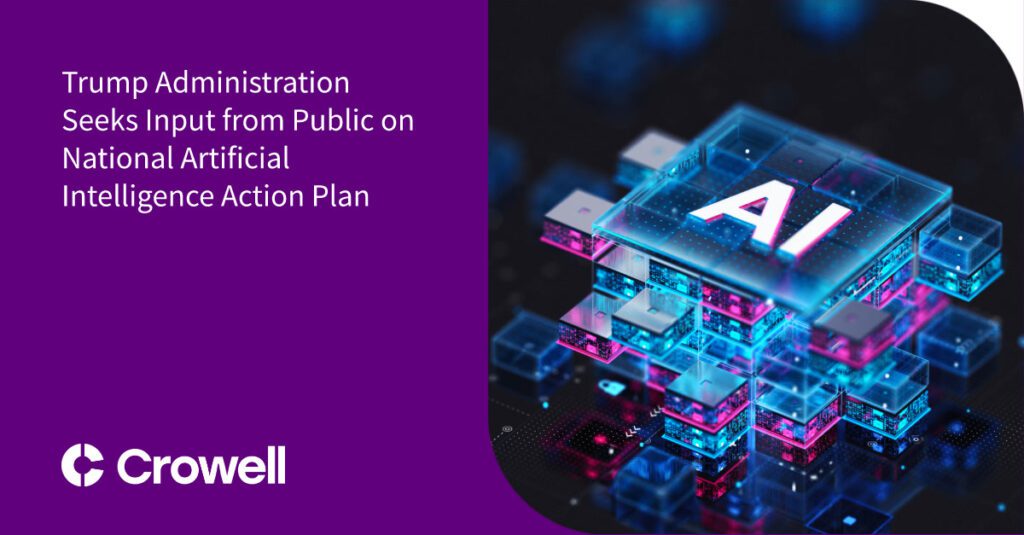At the outset of the new administration, substantial changes in U.S. technology policy are emerging, particularly in the realm of artificial intelligence (AI). President Trump has rescinded President Biden’s Executive Order 14110, known as the “Safe, Secure, and Trustworthy Development and Use of Artificial Intelligence,” amid a series of executive actions on his first day. The administration is swiftly taking steps to establish its priorities in AI as it aims to bolster U.S. leadership and competitiveness in this area, especially in competition with the People’s Republic of China.
As part of this initiative, a public Request for Information (RFI) has been published in the Federal Register regarding the formulation of a national AI Action Plan, allowing stakeholders to contribute ideas and suggestions.
AI Action Plan RFI
On February 6, 2025, the National Science Foundation (NSF), representing the White House Office of Science and Technology Policy (OSTP), issued an RFI to gather public feedback for the development of a national AI Action Plan. Launched by Trump in his January 23, 2025, Executive Order 14179, titled “Removing Barriers to American Leadership in Artificial Intelligence,” this initiative aims to identify priority policy actions necessary to maintain and enhance America’s dominance in AI while ensuring that excessive regulations do not hinder innovation within the private sector.
The RFI seeks input from various stakeholders, including academia, industry groups, government entities, and other interested parties. It calls for recommendations on tangible AI policy actions across a wide array of topics, such as:
- Hardware and chips
- Data centers
- Energy efficiency and consumption
- Model development
- Open-source development
- Applications and use
- Explainability and assurance of AI outputs
- Cybersecurity
- Data privacy throughout the AI lifecycle
- Risks, governance, and regulation
- Technical and safety standards
- National security and defense
- Research and development
- Education and workforce
- Innovation and competition
- Intellectual property
- Procurement
- International collaboration
- Export controls
Submissions should be received by 11:59 PM ET on March 15, 2025. This RFI serves as a crucial opportunity for diverse stakeholders to influence U.S. policy on AI.
The AI Action Plan Reflects Trump’s Deregulatory Stance
The proposed AI Action Plan reflects President Trump’s deregulatory inclination, marking a clear shift from President Biden’s more cautious AI policy. The new administration argues that the former policy imposed excessive constraints on private sector innovation, threatening U.S. AI leadership. In Executive Order 14179, Trump instructed federal agencies to assess and potentially amend or repeal measures from Biden’s order that conflict with the current administration’s goals. This includes updates to OMB Memoranda concerning the government’s use and acquisition of AI. Additionally, the launch of “Project Stargate” at the White House aims to enhance U.S. AI capabilities in collaboration with major private sector entities, targeting an investment of $500 billion in AI infrastructure over the next four years.
Anticipating Responses to DeepSeek
Concerns about U.S. leadership in AI have escalated notably since the rise of the Chinese AI firm DeepSeek, whose generative AI app “R1” has quickly gained popularity, even surpassing U.S. alternatives. This development raises questions about the sustainability of American tech dominance, especially as DeepSeek claims to have developed its app at a significantly lower cost, utilizing less advanced chips than its U.S. counterparts. Critics are now questioning the effectiveness of U.S. export controls focused on high-end chips, which presumed such access was critical for innovation. Alongside these geopolitical concerns, there are numerous operational worries globally regarding DeepSeek’s practices in data storage, cybersecurity, and overall safety.
EU’s AI Regulation Approach Highlights Differences
The European Union has taken a risk-based approach with its Artificial Intelligence Act, targeting high-risk applications, whereas the U.S. policy under the Trump administration may hinge on a less regulatory-focused stance. This divergence emphasizes how the U.S. defines “risks” worthy of regulation. The EU has recently indicated a shift away from strict liability frameworks for AI systems to stimulate innovation and enhance competitiveness, even amidst its comprehensive digital regulation landscape. Stakeholders from both regions may weigh in on these approaches, potentially highlighting the implications of regulatory compatibility amid current geopolitical tensions.
Federal AI Policy’s Relation to State Legislation
While federal branches have been actively studying AI’s influence on the U.S. economy, states are also enacting diverse AI legislation covering issues like employment and insurance decisions. This state-level legislation closely aligns with the broad topics in the RFI. Businesses have a chance to express their views on state policy trends through the RFI, which could guide federal attention on specific issues. Overall, the landscape of AI regulation in the U.S. is poised for significant evolution, influenced by both federal directives and state-level initiatives.




